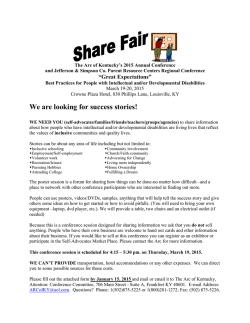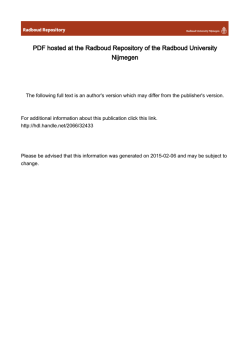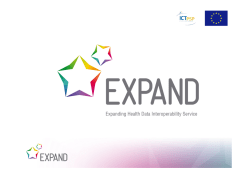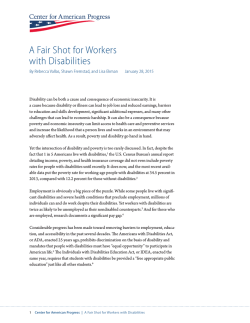
February 6, 2015 By electronic mail Dr. Karen DeSalvo, MD National
February 6, 2015 By electronic mail Dr. Karen DeSalvo, M.D. National Coordinator for Health Information Technology U.S. Department of Health and Human Services 200 Independence Avenue SW, Suite 729D Washington, D.C. 20201 re: Consumer Partnership for eHealth’s Comments on Federal Health IT Strategic Plan 2015-2020 Dear Dr. DeSalvo, Thank you very much for the opportunity to provide input on the federal government's draft strategic plan for health information technology in 2015-2020. The Consumer Partnership for eHealth (CPeH) is a coalition of consumer, patient and labor organizations working at the national, state and local levels to advance private and secure electronic health information exchange (health IT) in ways that measurably improve the lives of individuals and families. Led by the National Partnership for Women & Families, the combined membership of CPeH represents more than 127 million Americans. A. Advancing a Culture of Better Care, Better Health and Better Value by Engaging Patients and Families as Equal Partners At the outset, we highlight and applaud a core tenet of the draft Strategic Plan: that individuals, family caregivers, and communities should be equal partners in the Plan's objectives and outcomes for 2015-2020. Goal 2, on interoperable health information, lifts up a core objective that individuals, like providers and public health entities, be able to send, receive, find and use electronic health information securely. Goal 4 highlights the need to advance the health and well-being of individuals and communities, and a core objective to empower individual, family and caregiver health management and engagement. Indeed, better care, better health and better value absolutely depend upon patients' and communities' being equal and engaged partners in these efforts.1 We are heartened to see specific attention to individuals, patients and communities woven into the plan at many points. For purposes of brevity, we refer throughout our comments to “patient” and “care,” given that many federal programs and initiatives are rooted in the medical model. To some, these terms could imply a focus on episodes of illness and exclusive dependency on professionals. Any effort to improve patient and family engagement must include the use of terminology that also resonates with the numerous consumer perspectives not adequately reflected by medical model terminology. For example, people with disabilities frequently refer to themselves as "consumers" or merely "persons" (as opposed to patients). Similarly, the health care community uses the terminology “caregivers,” while the independent living movement may refer to “peer support.” 1 Better care and better health also depend upon interoperability with "nontraditional" sources of relevant health data such as patient-generated health data, social determinants of health, and community resources. These have long been common sources of health information in the experience of individuals and communities, which use them regularly to manage health and care outside clinical settings.2 Goal 4 rightly incorporates the need to address local social and health determinants and non-clinical health indicators, which are particularly important for providers serving vulnerable populations with more complex needs, such as community health centers. The Consumer Partnership applauds this strategic planning. And patients and communities will often be the best source of these data. In the comments that follow, we provide a few more general observations about the Strategic Plan and its goals and principles and more detailed discussion of some important outcomes or strategies we find missing; and pertinent results from a nationwide survey the National Partnership for Women & Families just released in December that supports the draft Strategic Plan in key respects and helps to explain what we find missing. Our detailed comments about the Strategic Plan are collected in the attached table. B. The Strategic Plan's Goals and Principles We appreciate how much the Strategic Plan packs into each goal, objective, outcome, and strategy. The Plan could amplify this contribution, however, by better highlighting for stakeholders the interconnections among the goals and objectives. ONC takes care to clarify that these goals most occur concurrently in conjunction with each other. Further reinforcing this point—whether textually or graphically—might help stakeholders better appreciate opportunities to leverage work on one goal or objective in order to achieve others as well. We also recommend some revision to the federal health IT principles: Firstly, we urge you to add a principle that specifically references the potential of health IT to engage and empower consumers in their health and care. 2 According to an assessment by the Robert Wood Johnson Foundation, medical care delivery determines only an estimated 10 15 percent of health. The remaining 85-90 percent of health is determined by other factors, such as health behaviors, genetics, and the socioeconomic and physical environment (e.g., access to education and job opportunities, housing, public safety, language services, availability of places to exercise, healthy food choices, and other environmental factors). Robert Wood Johnson Foundation, Frequently asked questions about the social determinants of health (2010), available at http://www.rwjf.org/content/dam/files/rwjfwebfiles/Research/2010/faqsocialdeterminants20101029.pdf. The Institute of Medicine (IOM) recently recommended social and behavioral domains and measures for electronic health records, in order to capture the social determinants of health. Institute of Medicine, Capturing Social and Behavioral Domains in Electronic Health Records: Phase 1 (Apr. 8, 2014), available at http://iom.edu/Reports/2014/Capturing Social and Behavioral Domains in Electronic Health Records Phase 1.aspx?utm_medium=etmail&utm_source=Institute%20of%20Medicine&utm_campaign=04.08.14+New+Repor t+ +EHR+1&utm_content=&utm_term=. This principle goes well beyond recording and respecting preferences, to the patient engagement we need to achieve the Triple Aim, enabled by health IT. Secondly, we believe that a principle on health equity is missing. The value of and current barriers to electronically connected and coordinated care are not the same for everyone, including underserved communities, communities of color, people who speak languages other than English, people with disabilities, LGBT individuals, and rural communities. To succeed, we must anticipate, design and build for the diversity of patient populations. A principle of health equity guides agencies and stakeholders to consider this principle as well in their work to come. C. Four Key Outcomes or Strategies Are Missing for 2015-2020 The attached table provides detailed comments about the Strategic Plan, including specific discussion of outcomes and strategies the Consumer Partnership especially supports, and those on which it seeks clarification and encourages amendments. Below we explain four carefully selected outcomes or strategies that the federal strategic plan is missing for 2015-2020 and should include as focal points. 1. Objective 1A: An Outcome to Increase Online Access for Patients and Healthy People Objective 1A would increase the adoption and effective use of health IT, and includes a three-year outcome to increase the percentage of hospitals and professionals who successfully demonstrate meaningful use of certified EHR technology. While laudable, the objective is missing an equally essential outcome for patients and healthy individuals, to increase as well their access and effective use of health IT. Only by including patients as well can the objective move beyond the basic adoption of EHRs to their effective use to engage and improve the health and care of individuals. A national survey by the National Partnership for Women & Families found that patients find EHRs significantly more useful than paper-record systems for health and health care, across key domains such as following the doctor's instructions for treatment or care, helping patients take and refill medications as prescribed, and tracking progress toward individual health goals.3 When providers offer patients online access to their health information, 86 percent use it.4 Patients report that online access has a positive impact their knowledge of their health, the quality of their care, the ability to correct information in the medical record, and even their desire to do something to improve their health.5 Not only does online access improve patients' behaviors across these domains, 3 National Partnership for Women & Families, Engaging Patients and Families: How Consumers Value and Use Health IT (Dec. 2014), pp. 21-25, available at http://www.nationalpartnership.org/research-library/healthcare/HIT/engaging-patients-and-families.pdf. 4 Ibid, pp. 28-29. 5 Ibid, p. 29. but more frequent online access increases these behaviors significantly more. For example, the more frequently individuals access their health information online, the more they report that it motivates them to do something to improve their health—71 percent of patients using online access three or more times per year, compared with 39 percent who used online access less frequently.6 For these reasons, objective 1A should add a parallel three-year outcome for patients alongside its outcome for hospitals and professionals: 3-Year Outcome: Increase the percentage of patients who are offered and use online access. The Strategic Plan should pursue this outcome across all federal programs and policies, not just the Meaningful Use program. 2. Objective 2A: An Outcome to Advance Access for More than 60 Million Americans The Strategic Plan recognizes that “[s]uccessful implementation of the Plan will also mean that health IT is culturally and linguistically sensitive, safe, accessible for everyone (including those with limited English proficiency or with disabilities) . . . .” Unfortunately, the Plan is missing a specific outcome to advance access for 60.5 million Americans who speak a language other than English at home7 and 56 million Americans with a disability.8 Accordingly, the Consumer Partnership urges the addition of a three-year outcome for successful implementation of the Plan: 3-Year Outcome: Increase the capacity of health IT to be accessible for people with limited English proficiency (especially the top five non-English languages used nationally) and people with disabilities. Such access is also fundamental for interoperability. As ONC's initial Interoperability Roadmap stated, an interoperable health IT ecosystem makes the right data available to the right people at the right time, so that recipients can meaningfully use that information. But for the patient who cannot use patient portals or read visit summaries or hospital discharge instructions in English, there is no interoperability. 6 Ibid, pp. 29-30. 7 U.S. Census Bureau, Language Use in the United States: 2011 3 (2013), available at http://www.census.gov/prod/2013pubs/acs-22.pdf. 8 U.S. Census Bureau, Americans with Disabilities: 2010 4, 8-9, 17-19 (2012), available at http://www.census.gov/prod/2012pubs/p70-131.pdf%20. 3. Goal 4: An Outcome to Reduce Health Disparities Identification and reduction of health disparities is a national imperative, and health IT is an essential tool for reducing disparities in health and care. Goal 3 and objective 5C mention reducing health disparities, and objective 5C includes a strategy to assess the impact of health IT to reduce disparities, but we find no concrete objective or outcome to use health IT to reduce health disparities. The Consumer Partnership for eHealth recommends that the Strategic Plan add to Goal 4 a three-year outcome on using health IT to reduce health disparities: 3-Year Outcome: Increase collection of electronic health information (such as granular demographic data, patient-generated health data, data about social determinants of health, etc.) and use of health information technology to reduce health disparities. Goal 4 is an ideal place for such an outcome because reducing health disparities involves examining both population or community patterns and individual health and care. 4. Objective 4B: A Strategy to Incorporate and Use Social and Environmental Determinants of Health As we mentioned above, Goal 4 includes local and social determinants of health, and Objective 4B includes a six-year outcome to increase use of health IT in enhancing public health situational awareness by incorporating environmental, psychosocial and other non-medical information into providers' workflow and health care records. We note, however, that there is no corresponding outcome or strategy under Objective 4B to advance the capacity of electronic health records and health IT to integrate social and environmental determinants of health. We recommend adding a strategy (similar to strategy 2): Expand the capacity of health IT to integrate, share and use social and environmental determinants of health in managing the care and health of individuals and communities. Such a strategy might guide the federal agencies, for example, in identifying and incorporating standardized methods to record and use social determinants of health to promote a learning health system. Identifying standardized ways to record and use social determinants of health also has important implications for patient-generated health data because, in many instances, patients will be the best source of information about social determinants of their health. The Institute of Medicine recently recommended social and behavioral domains and measures for electronic health records, in order to capture the social determinants of health. We recognize that this is not a national strategic plan for health IT, such as the HITECH Act's national plan. Yet as a federal strategic plan for health IT, guiding over 35 federal entities that provide direct health care and health insurance, protect public health, fund health and human services for specific populations, invest in health IT infrastructure, develop and enforce policies and regulations, and advance critical research, this federal strategic plan can have far-reaching impact in the coming years. Thank you once again for this opportunity to provide input on the federal government's draft strategic plan for health information technology in 2015-2020. If you have any thoughts or questions about these comments, please contact Mark Savage at (202) 986-2600 or [email protected]. We look forward to continuing to work with the Office of the National Coordinator to ensure that patients and families realize the benefits of health IT as fully as possible in 2015-2020. Sincerely, [organizations listed in alphabetical order] National Partnership for Women & Families Attachment
© Copyright 2025







